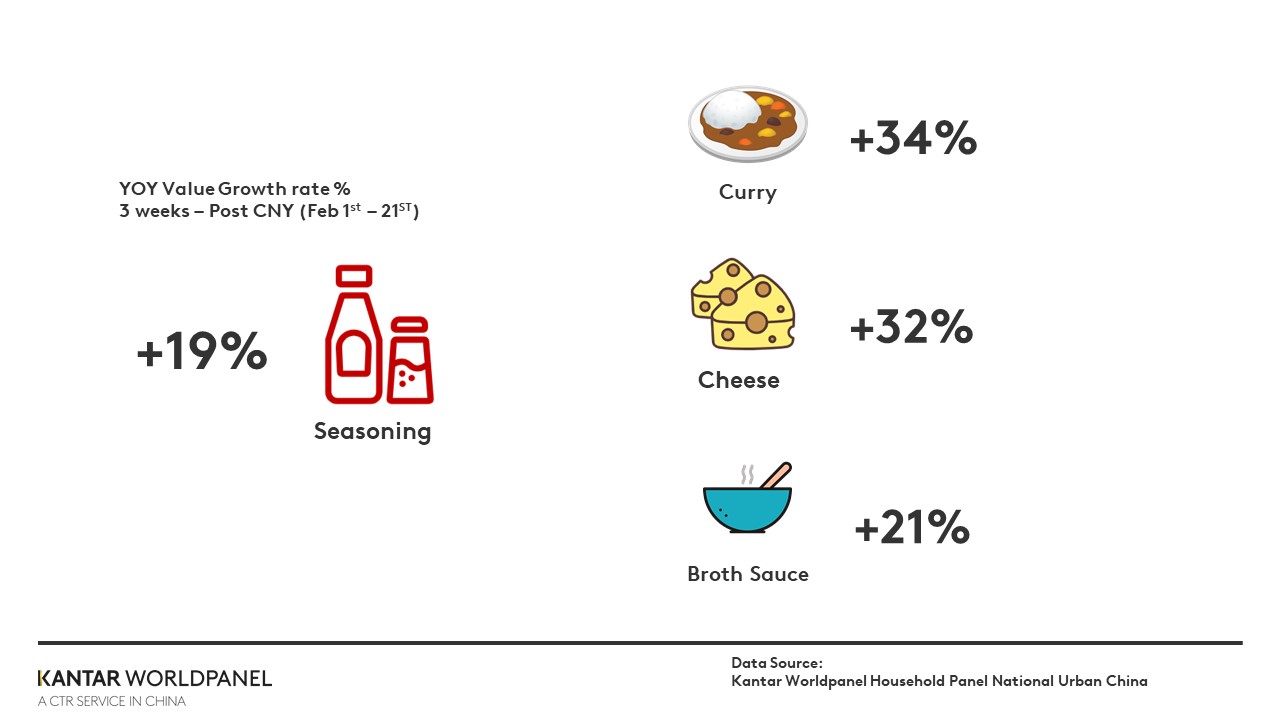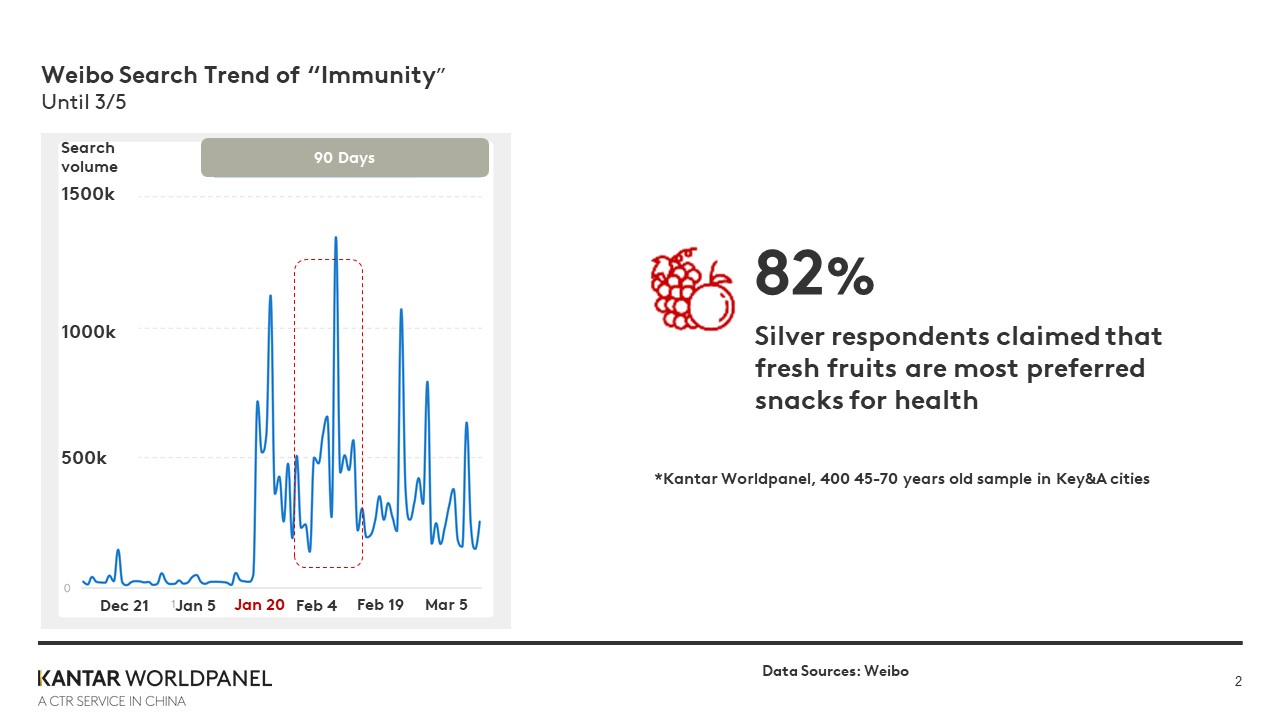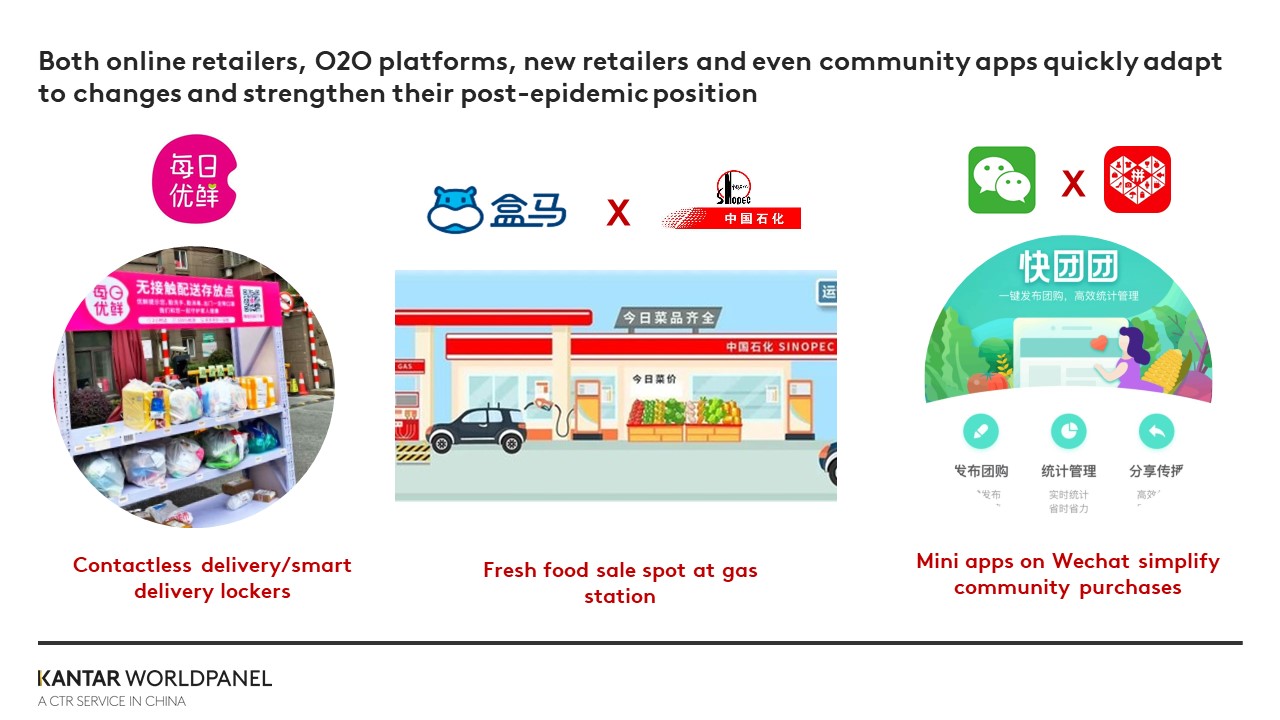Although the CPI in China increased by 5% in February, people’s demand for fresh food was not affected. In fact, Kantar Worldpanel’s household panel data shows a momentum in the growth of fresh food, in contrast to other FMCG categories, since the outbreak of COVID-19. There are three possible explanations for this.
Observation 1: Strict quarantine policy leading to more spare time for in-home cooking
Kantar’s nationwide survey in February 2020 revealed that 75% of respondents claimed to follow the quarantine policy and cancelled social activities during the pandemic. In the meantime, from Kantar Worldpanel’s survey conducted in North China, we found out that nearly half of respondents claimed to be buying more fresh food than before. The high year-on-year growth of cooking seasonings after the Chinese New Year also implies that consumers have been spending more time in the kitchen preparing meals.
In addition, cooking is a fun activity to kill time during the quarantine. Top growing sauces in our data are broth, curry and cheese, due to people’s interests in new cooking recipes. On Weibo, “homemade dish challenge” became a trending topic with over 2,260 million views. Also, searches for new cooking machines like rice cookers, barbecue grills, and blenders on ecommerce platforms further proved that new cooking occasions are growing in popularity in China.

Implication 1
In the short term, the “revenge-consumption” caused by COVID-19 will raise people’s interest in cooking and demand for new cooking recipes and ingredients. With more time spent with families and close friends at home, consumers will possibly keep the habit of in-home cooking, which implies that they will maintain their high demand and requirements for fresh ingredients. In normal times, “convenience” is a key need for in-home cooking due to people’s shortage of time. Curry, ketchup and other easy-to-cook sauces will be optimal choices for consumers.
Observation 2: Fresh food’s nutritional properties fit with people’s health concerns
There’s no doubt that COVID-19 has raised public interest in health. The number of searches on keywords like “health” and “immunisation” increased by over 1000% after the outbreak. Mainstream media like CCTV also reported that the protein and vitamins in fresh dairy and vegetables can boost immune systems. Moreover, more young people started to share their in-home cooking of veggie smoothies and healthy diets along with in-home workout through vlogs, which further encouraged more people to adopt a healthy lifestyle. The older, “silver” generation also claimed that they would spend more on fresh food than before to keep in good health.
In addition, many live-poultry markets are permanently shutting down and being replaced by industrial processes. Nevertheless, “fresh” meat, live freshwater fish and seafood are popular by consumers since their perception is that being alive is associated with healthy, high-quality products.

Implication 2
People’s increased attention on health will not decline as the pandemic goes away. On the contrary, three-quarters of respondents in a survey by Kantar's Health division said that they will be more concerned about health after the COVID-19 pandemic. It will bring new opportunities for manufacturers to add “nutritious” and “healthy” messaging to communications to follow this consumer trend and promote public health education. Healthy fruit and vegetable snacks also have some market potential. On the other hand, fresh retailers should not overlook the importance of poultry and meat products’ freshness and nutrition to attract consumers.
Observation 3: Outbreak acts as the catalyst for digital purchase behaviour
Driven by the rapid development of mobile ecommerce, the delivery of fresh food has been sky-rocketing since 2018. Traditional channels like free-marts will continue to lose share. In 2019, the average number of channels through which a shopper buys fresh food increased to five. As expected, consumer demand for fresh delivery has surged during the COVID-19 period. Many O2O and ecommerce platforms like Miss Fresh also introduced “contactless” delivery to avoid direct contact. In Jan 2020, O2O and online penetration for fresh food reached 20% and 22% respectively in Urban China. The online penetration particularly shows a fast-moving trend toward less developed areas: tier 2 and 3 cities; and the silver generation with their increased mobile usage. Wechat is another popular channel for the community or neighbourhood purchase of fresh food. A survey by Kantar's Consulting division found that nationwide, 35% of respondents used Wechat for fresh purchases in February 2020.

Implication 3
With the arrival of O2O 2.0 bringing in new buyers, fresh food retailers should consider how to retain them after COVID-19. By 2022, Online + O2O is expected to triple its market size, projected to reach 15% market share in the fresh food category. According to Kantar data, 42% of new online buyers claimed that they will consider a combination of online and offline shopping after the pandemic, which means that omni-channel is the key trend for fresh purchase.
On the other hand, as online limits the consumer’s selection process, one of most common complaints is the consumer’s low satisfaction of fresh product quality. Therefore, especially for O2O channels, it is really important to retain consumers by providing high quality, fresh products. Meanwhile, retailers should collaborate with manufacturers to adapt their offer to new consumer needs who order from O2O or online. For example, since convenience and health are two significant market trends, offer “convenient” combination packs, such as multi-fruit snack packs. Moreover, in view of different family sizes, fresh dish ingredients packed along with recipes fitted to specific family needs could be more attractive. Also, nutritional facts summary and health benefits could be added in a product page description in addition to fresh delivery details.

